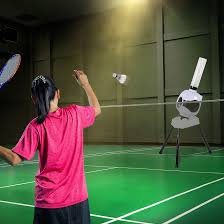AI Robot Now Plays Badminton With Humans — A Glimpse Into the Future of Human-Machine

In a groundbreaking demonstration that bridges the gap between robotics and recreation, researchers have unveiled an AI-powered robot capable of playing badminton against humans — showcasing not only the agility of modern machines but also how close we are to human-like robot interactions in real-world environments.
The Tech Behind the Smash: What Makes It Possible?
Developed by a team of Swiss and German engineers from ETH Zurich and the University of Zurich, this badminton-playing robot uses a combination of computer vision, AI algorithms, and dynamic motion planning to track the shuttlecock and react in real time.
Key Features:
- Legged locomotion: The robot is built on a quadruped (four-legged) base, allowing it to move nimbly across the court.
- Real-time vision system: It tracks the shuttlecock mid-air using high-speed cameras and radar sensors.
- Predictive AI: It doesn’t just react — it predicts where the shuttlecock will land and plans its move accordingly.
- Arm-actuator with precision swing: The robot uses a mechanical arm to return shots with surprising accuracy.
This synergy of AI and biomechanics is what enables the robot to return serves, engage in rallies, and even execute smashes.
Why Badminton?
Badminton may seem like a fun choice, but it’s one of the most challenging sports for robotic systems due to:
- The light weight and erratic flight path of the shuttlecock
- The split-second decision-making required for every shot
- The necessity of both fine motor control (for hits) and gross motor agility (for movement)
This makes it a perfect testbed for evaluating real-time AI prediction, robotic reflexes, and human-level interaction.
Real-World Applications Beyond the Court
While playing badminton may sound like entertainment, the technological implications are far-reaching:
| Sector | Potential Impact |
|---|---|
| Healthcare | Robots capable of responsive movement can assist in physical therapy or elderly care. |
| Education | Interactive robots could engage with students in learning-through-play environments. |
| Disaster Response | Agile robots with real-time decision-making can be deployed in search-and-rescue operations. |
| Sports Training | Athletes may soon train with robots for repetitive drills and real-time feedback. |
Public Reaction & Demonstration Video
The robot was showcased in a public demo and received massive interest from both the tech community and casual audiences. Videos shared online showed it gracefully sidestepping, returning smashes, and adapting to different players’ playing styles — all in real time.
“This is more than a gimmick. It’s a window into the next phase of robotics: collaborative, entertaining, and highly adaptable,” said one ETH Zurich professor.
What’s Next?
With advances in AI learning, robotic muscle replication, and multi-modal perception, we may soon see robots participating in more complex sports and activities — not as replacements, but as partners, coaches, and teammates.
The future of robotics isn’t just industrial or utilitarian. As this badminton bot shows, it’s also interactive, fun, and increasingly human.
The badminton-playing robot is not just a cool tech stunt — it’s a symbol of progress in how machines perceive, move, and interact with us. Whether it’s on a factory floor or a badminton court, robots are learning to play by our rules — literally.







